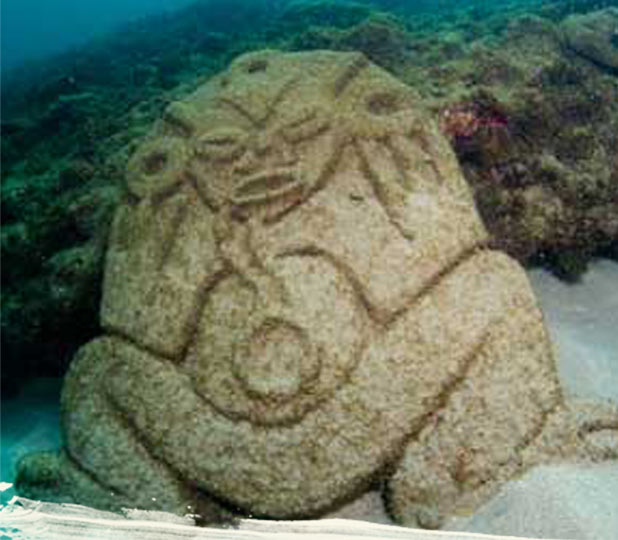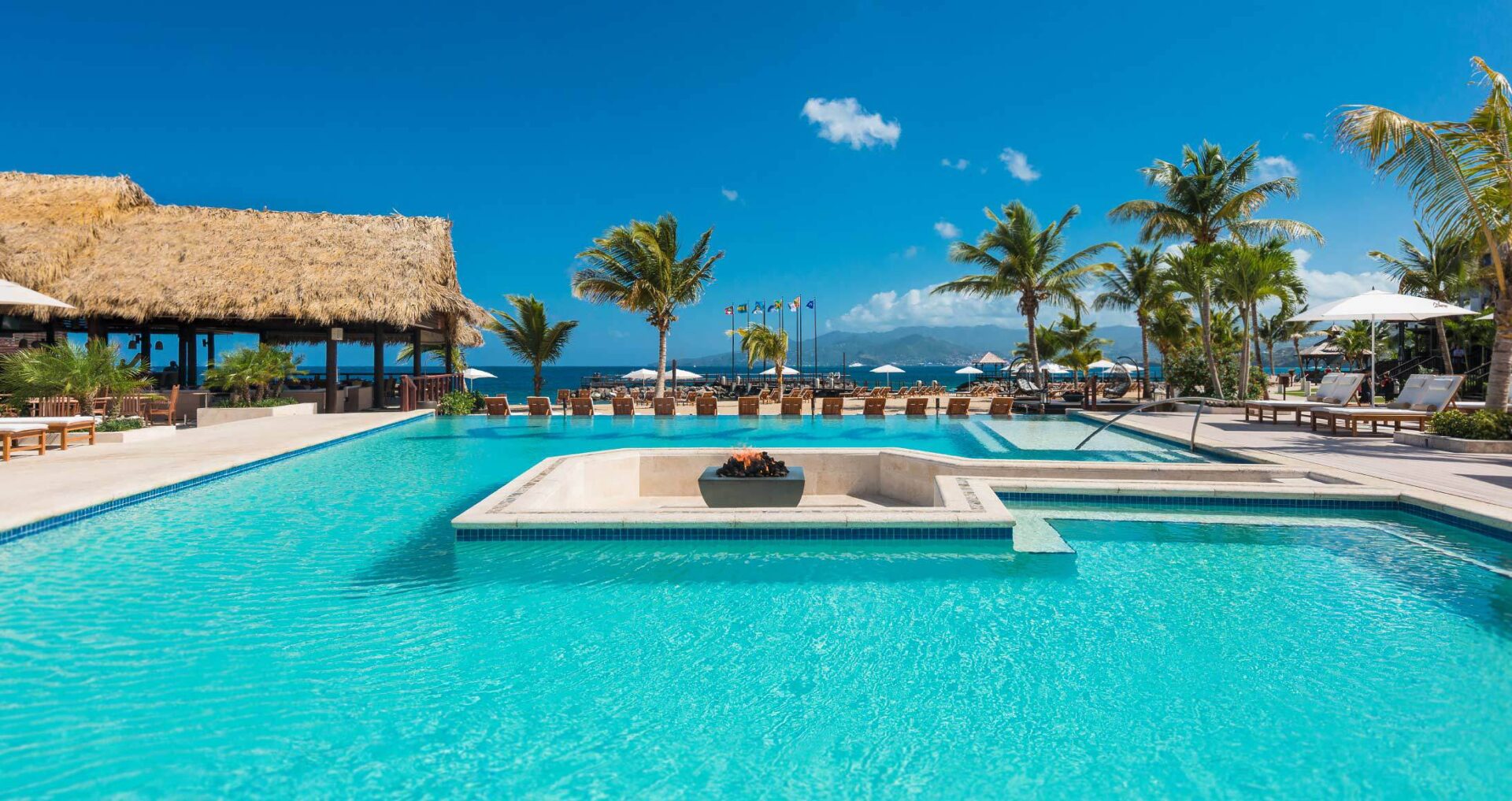The Sculptures
One of our most popular snorkeling sites is an underwater gallery of sculptures in our Molinere Beauséjour Marine Protected Area that very much reflect Grenada’s culture. Created by renowned sculptor Jason de Caires Taylor and installed in 2006, the underwater garden is fashioned from a variety of media but predominantly from simple substrates including concrete and rebar, which create an ideal substrate, relatively fixed and permanent, on which marine life may develop. They are sympathetically located to enhance the reef, making natural use of its varied topography of craggy gullies and sun-dappled sandy patches.
As artificial reefs, these sculptures are proving highly successful so far in attracting a stunning array of varied marine life. In doing so and attracting visitors, they have indeed fulfilled a role in easing the environmental pressure on other reefs in the locality.
A key aspect to the sculptures’ appeal has been the dynamic changes brought about by being exposed to the power of the ocean. Unique natural forces including sea surge, wave action and currents have imposed their own influence and changes on the sculptures.
We have attempted to give you a brief but by no means exhaustive description of the main sculptures below.
VICISSITUDES
Vicissitudes (by Jason DeCaires Taylor): is comprised of 26 male and female children holding hands in a circular formation which symbolically stands as a metaphor for the cycle of life Placed at 5m below the surface they undergo a metamorphosis prescribed by their underwater habitat. They are marked and patinated by the surrounding environment, echoing how we as children are affected and transformed by our surroundings. The sculptures constitute and represent process, chance, and organic transformation.

THE LOST CORRESPONDENT
(by Jason DeCaires Taylor): As the sculpture transforms and becomes part of the reef, it takes on the patina of obsolescence, the writer as communicator becomes a fossil in a lost world. Hidden beneath the waves, within a small opening at the end of a natural ravine, the sculpture is more “discovered” than it is exhibited.

SIENNA
(by Troy Lewis): A character from the story “A Different Ocean” by Grenadian author Jacob Ross. The young girl was a gifted diver exploited in a search for lost treasure.

THE UN-STILL LIFE
(by Jason DeCaires Taylor): is a classical composition of a fruit bowl, water jug and scattered fruit, placed on a rectangle table. As if petrified in stone, it is a reminder of the inevitability of change and in turn a reflection on our own mortality. Like Rene Magritte’s surrealist stone paintings Taylor endeavours to capture a mundane moment in time but undermine its presence by placing it a surreal context, questioning our eternal desire to control our surrounding and create moments of permanence. The folly of the Un-still life is the march of time can never be halted.

THE PETROGLYPHS
(by Troy Lewis): ten enlarged replicas of the stone carvings located in Duquesne and Mt. Rich. The original carvings were created by the Amerindians; early inhabitants of the Island, and date back to A.D. 600.

Christ of the Deep
(by Troy Lewis): A replica of the statue located on the Carenage in St. Georges. Gifted in thanks to the Grenadian people by the Costa cruise ship company for the help given to the crew and passengers of the fire-stricken ‘Bianca C’ in 1961.

Mermaid
(by Troy Lewis): Everyone loves the folklore of the sea. A being with the upper form of a beautiful woman and the lower half, the tail of a fish.

Nutmeg Princess
Nutmeg Princess (by Lene Kilde): A character made famous in a book by the Grenadian writer Richardo Keens-Douglas. If you were lucky with a good heart, you might see her, but to do so you had to rise at 4 a.m. and sit on the big stone by the old red rowboat at the edge of the lake. Two children are determined to do just that, and the townspeople follow along hoping to see her, but only the two children are gifted with a vision of her and her wisdom “Go now, follow your dreams, and if you believe in yourselves, all things are possible.” And then she was gone, never to be seen again.

THE SILENT CRY
(by Rene Froehlich): A face enveloped by organic roots struggling to survive in a world that is being dominated by human destruction of the natural environment.

Sentinels
3 installations of ‘Sentinels’; circles of 7 human figures; ensure an omnidirectional lookout and the protection of the ‘Sculpture Park’. The statues in the rings were derived from the original ‘Vicissitudes’ ring of children when it was replaced.

Bench + Selfie
(by Rene Froehlich): A depiction of the modern phenomenon of capturing oneself and the location with a smart phone.

Coral Carnival
(by Jason DeCaires Taylor): An installation of 25 large scale figurative works depicting a series of masqueraders from the local carnival called ‘Spicemas’, which is held annually during the month of August. The sculptures cast from local Grenadians celebrate some of the best-known masqueraders of the parade such as ‘Jab Jab’, Shortknee, Vieux Corps (Veko), Wild Indian and the extravagant Fancy Mas dancers.
The artist and Photographer for these images is Jason DeCaires taylor




La Diablesse
(by Troy Lewis): A character from Grenadian folklore.
Her large-brimmed hat conceals a hideous face. Her long dress hides a leg which ends in a cow hoof. She walks with one foot on the road, one foot on the roadside grass, the sound of her cloven hoof muffled. Her scent is a distinct mix of fine perfume and deadly decay.
She casts spells on her unsuspecting male victim and leads him into the forest. Once there, she disappears. The victim, confused, lost and scared, runs around the forest until he falls into a ravine or river, or gets eaten by a wild dog and dies.
To break the spell of La Diablesse, one must turn their clothing inside out and walk home backwards away from the area.

Mama Glo
(by Troy Lewis): Mama D’Leau (derived from the French Maman de l’eau or “Mother of the River”), also known as Mama Dlo and Mama Glo, is the protector and healer of all river animals, in the folklore of Grenada. She is usually depicted as a beautiful woman with long hair. From the waist downwards her body twists into the coils of a snake. Her tongue is forked, and she holds a golden comb which she passes through her snake-like hair.

Leatherback Turtle (Dermochelys coriacea)
(by Troy Lewis): the endangered leatherback sea turtle, is the largest of all living turtles and the heaviest non-crocodilian reptile, reaching lengths of up to 1.8 metres and weights of 500 kilograms. They are annual visitors to Grenada’s Northern beaches between March to June to lay their eggs before returning to their feeding grounds many thousands of miles away.
Belair Dancer
(by Troy Lewis): The bélé; a folk dance of Creole Caribbean origin found in Grenada, St. Lucia, Dominica, and Trinidad & Tobago. It may be the oldest Creole dance of the creole French West Indian Islands, and it strongly reflects influences from African fertility dances. It is performed mostly during full moon evenings, or sometimes during funeral wakes.





